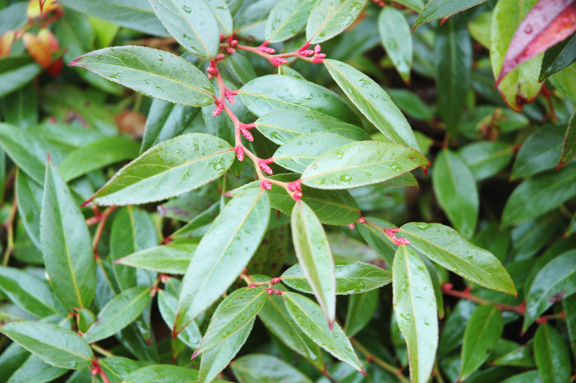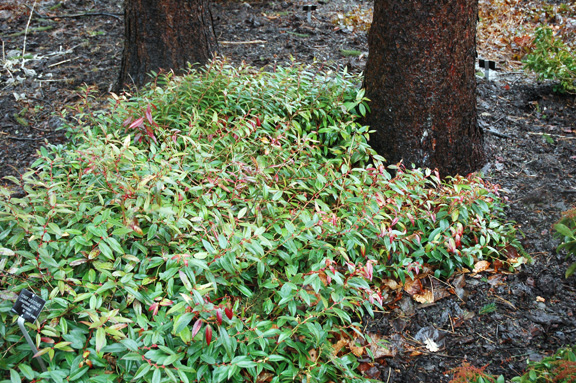
Woody > Leucothoe > Leucothoe axillaris > Leucothoe axillaris
Leucothoe axillaris
Dog-hobble, Coast Leucothoe
Origin: Southeastern United States
Mike's
Opinion


"
Leucothoe axillaris is native to Southeastern United States, from Florida to Virginia in the north and Louisiana to the west. In 1783 it was first described by J.B. Lamarke as Andromeda, but 50 years later was determined to be from a new genus named Leucothoe by David Don. In gardens, Leucothoe axillaris is a shrub commonly used as a spreading cover. Since it grows well in moist, acidic, sand, loam or clay soils, it is suitable for many gardens, provided it is protected from wind. Clusters of drooping, slightly fragrant pinkish-white flowers emerge mid-spring. Copper leaves turn leathery and glossy green as they mature and maroon in the winter, providing year round colour.
Michael Pascoe, NDP., ODH., CLT., MSc. (Plant Conservation)
"
| Family |
| Ericaceae |
| Genus |
| Leucothoe |
| Species |
| axillaris |
| Category |
| Woody |
| Type |
| Shrub (evergreen) |
| Pronunciation |
| USDA Hardiness Zone |
| 6a - 9b |
| Canadian Hardiness Zone |
| 5b - 8a |
| RHS Hardiness Zone |
| H3 - H7 |
| Temperature (°C) |
| -23 - (-1) |
| Temperature (°F) |
| -10- 30 |
| Height |
| 0.5 - 2 m |
| Spread |
| 2 - 3 m |
Photographs
Description and Growing Information
Flowering Period
| General Description |
| Leucothoe axillaris is a broadleaf evergreen shrub with arching green to reddish branches, leathery, serrate leaves and slightly fragrant white flowers. |
| Landscape |
| Can be used as ground cover, hedging, underplanting, foundation plant, border plant or on slopes. |
| Cultivation |
| Grows well in part shade, in moist, acidic, sand, loam or clay soils. Intolerant of windy conditions and salt. Plantings should be spaced 1 - 1.5 m apart. Protect with mulch for winter survival in colder regions. |
| Shape |
| Spreading, vase-like. |
| Growth |
| Medium |
| ID Characteristic |
| Compact, low-growing, evergreen, arching branches; racemes of white, fragrant bell-shaped flowers. |
| Pests |
| No serious pests or diseases to note. Possible diseases include: leaf gall, powdery mildew, blight and spot anthracnose. Root rot is an occasional problem. |
| Habitat |
| Swamps, wetlands, and beside streams. |
| Bark/Stem Description |
| Thin, green when young turning brown with reddish upper side. |
| Flower/Leaf Bud Description |
| Overlapping scales are bright red on top and greenish underneath; 0.4 - 0.6 cm long. |
| Leaf Description |
| Alternate, thick, leathery, lance-shaped, pinnate venation, serrated margin, glossy dark green changing to puplish-bronze in the winter, 5 - 10 cm long with a 1 cm petiole. |
| Flower Description |
| White, drooping, bell shaped, slightly fragrant, 2.5 - 5 cm long in 2 - 5 cm long racemes originating from the leaf axil. |
| Fruit Description |
| In autumn, tiny, dust-like, amber seeds emerge from oval-shaped, 0.5 cm diameter, dry pods that open in a star-shape, along 5 sutures. |
| Colour Description |
| Younger leaves are a rich copper colour changing to glossy dark green then purplish-bronze in winter. The flowers are white, fruit is brown and branches green when young turning brown with a reddish upper side as they mature. |
| Texture Description |
| A medium textured plant. |
| Notable Specimens |
| Niagara Parks Botanical Garden, Niagara Falls, Ontario, Canada. |
| Propagation |
| By semi-hardwood cuttings rooted in October. It is best to strip the bottom leaves up to 2.5 cm and use a rooting compound 3000 ppm IBA-talc to promote new root growth. Plant in a soil mix of 5 parts peat, 2 parts coarse perlite, 2 parts fine perlite and 1 part sand. Provide bottom heat between 65° - 70° F in a greenhouse. Mist occasionally to prevent dehydration for 6 - 8 weeks then rooted cuttings can be transplanted. Can also be propagated by seed sown on milled peat moss, uncovered, in a humid environment. Germination occurs in 3 - 5 weeks. |
References
Cullina, William. Native trees, shrubs, & vines: a guide to using, growing, and propagating North American woody plants. Boston, NY: Houghton Mifflin, 2002. Print.
Fralish, James S., and Scott B. Franklin. Taxonomy and ecology of woody plants in North American forests (excluding Mexico and subtropical Florida). New York: John Wiley & Sons, 2002. Print.

